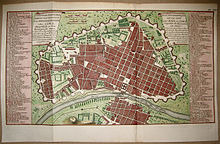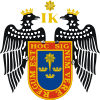|
Lima District
Lima (Spanish pronunciation: [ˈli.ma]), also known as the Cercado de Lima, is a district of the eponymous province of Lima, Peru. It is the oldest district of the province and as such, vestiges of the city's Spanish era remain today in the city's historic centre, which was declared a UNESCO World Heritage Site in 1988 and contains the foundational area once surrounded by the city's walls. History The city of Lima was founded by Francisco Pizarro on January 18, 1535, and given the name City of Kings.[2][3] Nevertheless, with time its original name persisted, which may come from one of two sources: Either the Aymara language lima-limaq (meaning "yellow flower"), or the Spanish pronunciation of the Quechuan word rimaq (meaning "talker", and actually written and pronounced limaq in the nearby Quechua I languages). It is worth nothing that the same Quechuan word is also the source of the name given to the river that feeds the city, the Rímac River (pronounced as in the politically dominant Quechua II languages, with an "r" instead of an "l"). Early maps of Peru show the two names displayed jointly. Under the Viceroyalty of Peru, the authority of the viceroy as a representative of the Spanish monarchy was particularly important, since its appointment supposed an important ascent and the successful culmination of a race in the colonial administration. The entrances to Lima of the new viceroys were specially lavish. For the occasion, the streets were paved with silver bars from the gates of the city to the Palace of the Viceroy.[citation needed] In 1988, UNESCO declared the historic centre of Lima a World Heritage Site for its originality and high concentration of historic monuments constructed during the viceregal era.[4][2] In 2023, it was expanded with two exclaves to include the Quinta and Molino de Presa and the Ancient Reduction of Santiago Apostle of Cercado.[4] GeographyThe district has a total land area of 21.98 km2. Its administrative centre is located at 154 meters above sea level. Boundaries
Neighbourhoods
At its northern and southern edges, there are clusters of residential areas, particularly in the southern zone bordering Pueblo Libre, San Miguel and Callao Region's Bellavista District. Demographics According to a 2005 estimate by the INEI, the district has 278,804 inhabitants and a population density of 15,736.9 persons/km2. In 1999, there were 75,595 households in the district. The high point of Lima's religious calendar for the masses is a month of festivities in October dedicated to the Lord of Miracles, during which take place several processions in the city. See alsoReferences
External linksWikivoyage has a travel guide for Central Lima.
|
||||||||||||||||||||||||||||||||||||||||||


